Painting and decorating the Wild One Off-Roader bodyshell
JI think the best advice is not to remove the protection film from the bodyshell. Just leave it there. Then, you need to choose between two options: either you cut and you apply the paint, or you apply the paint, then cut and probably re-apply paint on cut edges.
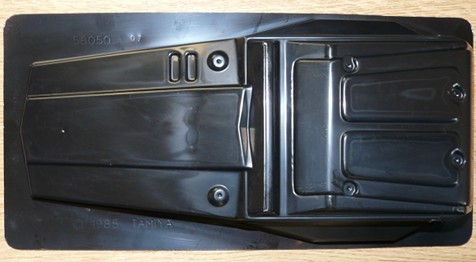
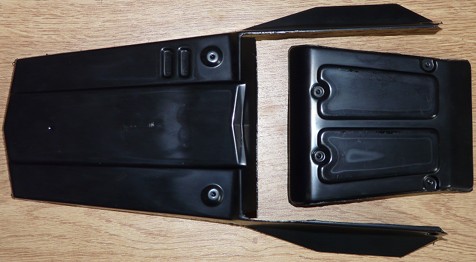
If you have a close look at the first photo, you may see a surprising anachronism: the reference shown at the top left side is "58050", and the copyright at the bottom left says "1985". However, if you already have read the models numbering section, you know the original Wild One reference was "5850" since the middle "0" was only introduced with the kit 58066. Conclusion: the reference should be either 5850 with a 1985 copyright or 58050 with a 2012 copyright. This is only a detail since it doesn't affect the model (but pure collectors would certainly care a lot on this aspect).
Back to concrete: as you can notice, the Wild One Off-Roader bodyshell is pretty tortured and shows some very difficult angles to cut (especially the band at the rollcage pillars). I chose to paint, cut and re-apply a coat along the cut edges because the lines to follow for cutting were easier to identify. But I would say both options are the same and you only need to choose the one you feel more comfortable with once you have the bodyshell in your hands.
Next, drill the front body mount hole, the headlights' and the body mounts' at the rear. We let the roof apart for a moment and will get back to it later on. Now, you can remove the protection film to see the result of your painting:
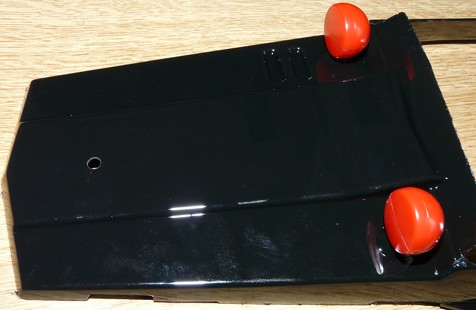
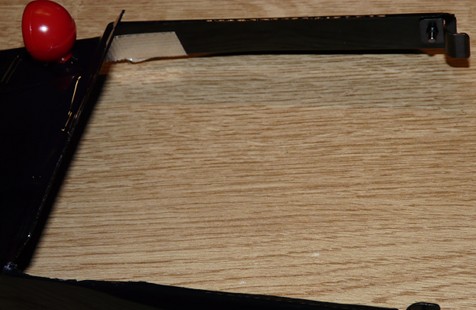
The body mount system is a classic body mount at the front and plates at the rear that will be maintained by the rollcage pillars. It may look somewhat weak at first sight, but the rear plates can't move freely along the rollcage pillars so the whole bodyshell seems to keep in place quite easily. As you can see, there are aluminum glass tape bands placed on the inside of the body (a few centimeters right from the headlight on the second photo): this is to protect the body since it will get in contact with the rollcage pillars.
Again, we leave the roof apart for the moment since it comes latest at assembly. Before, we need to take care of Ray Lynch, the driver.
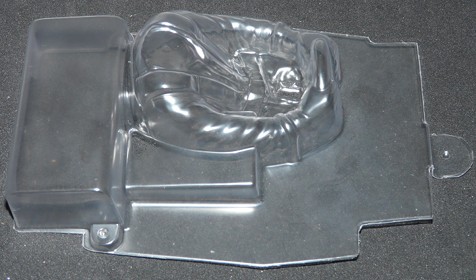
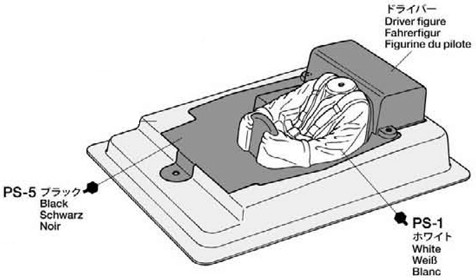
Well, let's be direct: this won't be an easy job! As you can see, the driver and cockpit are entirely molded in lexan. If you follow the manual instructions, Tamiya recommends to spray the driver white and the cockpit black. What they don't recommend is how to mask the white since the surface is not flat. Extra bonus: the driver's head is molded into a red resin on which Tamiya warns us that "the paint may come off easily"... what a promise ![]()
So, to make it short, here is the situation:
- extremely complex masking, close to impossible
- paint will have a shining look since we paint from the inside (especially worrying for the driver)
- painting acrylic white from the outside to get the flat white for the driver will be at cost of a "dirty" white due to the black background
So, I came with a 4 step solution mixing the different options we have:
- mask the cockpit as best as you can to clear the driver. Spray it white from the inside
- remove the mask and spray the cockpit and the driver in black from the inside
- repaint the driver in white, this time from the outside and with flat acrylic paint (XF2)
- again from the outside, use black acrylic paint (X1) to redraw the white limits (correcting masking failures) and flat black XF1 for the wheel
Well, let's go concrete: the cockpit was masked following the driver edges. It is not a great precision job, thus the 4th step listed above. Next, spray white from the inside:
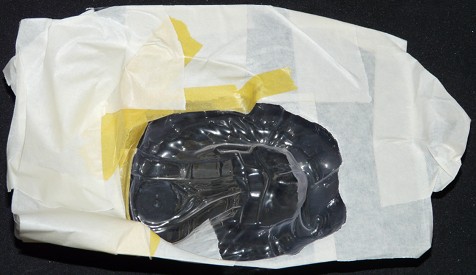
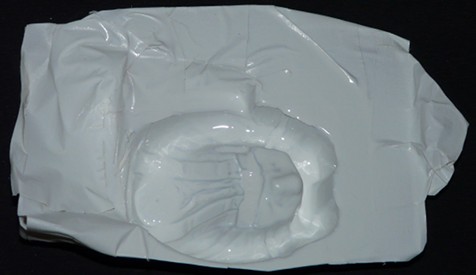
Remove the mask and spray the black, still from the inside. The white color got a little bit darker, but this is normal. See how useful the protection film is?
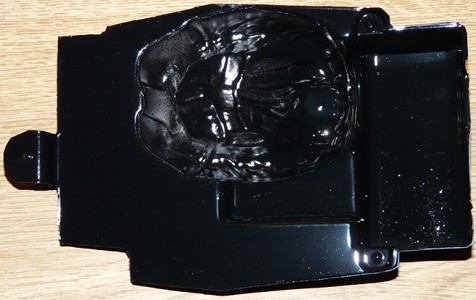
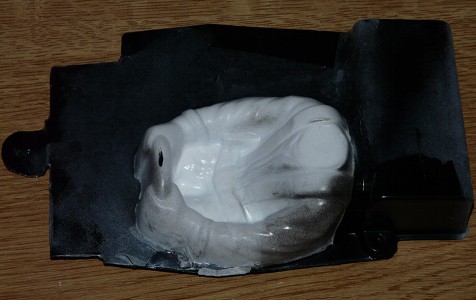
Now, details: remove the protection film and repaint the driver with flat white acrylic from the outside (don't forget his hands). Next, redraw the driver edges using acrylic black (not flat) from the outside:
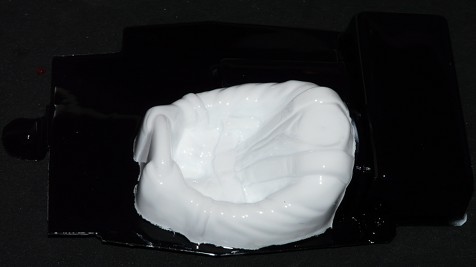
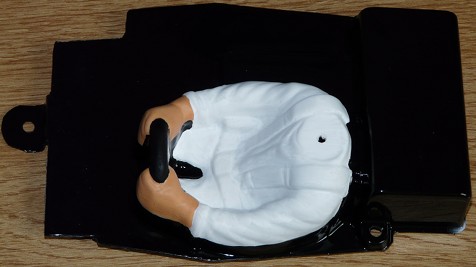
The final result is no true art, but it came better than I would have expected.
Concerning the driver's head, it is going to be hard to paint more than details. Actually, as Tamiya clearly says in the manual, "G parts are made from nylon resin. Paint may come off easily". The bad news is that Ray Lynch's helmet should be white as per the boxart when the G part tree is red colored... or?
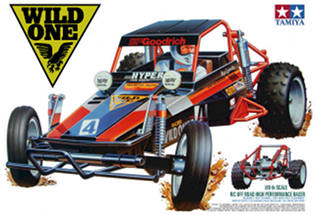
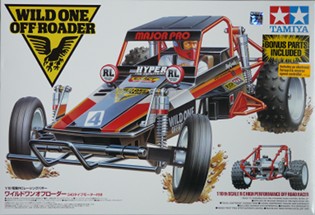
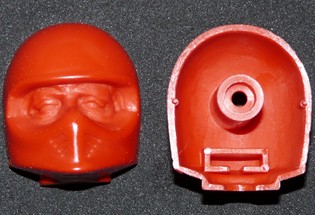
Or there is a subtle change of color between the original and the re-released boxart: the driver's helmet turned from white to red. Problem solved ![]() . In case you really want to paint the helmet another color (let's say white), I made a few tests using G tree parts:
. In case you really want to paint the helmet another color (let's say white), I made a few tests using G tree parts:
- acrylic with no surface preparation
- acrylic on sanded surface
- acrylic on sanded + primered surface
As per logic, the more prepared surface before painting, the less catastrophic result. But the result never could be considered as correct: at best, the paint turns into a kind of elastic skin that peels at touch. I performed the exact same series of tests using TS paint (for ABS resin): at best, results are the same as with acrylic paint.
However, if you want the helmet to look bright instead of semi-gloss, I recommend you paint it with X-27 Clear Red acrylic paint. Actually, this paint is a red colored lacquer meant to paint the transparent rear lights on cars. Once applied on the helmet, it is the best solution I could come with to get a glossy aspect. Another good aspect: it doesn't peel off and strongly sticks to the resin.
Even if we now have a solution for the helmet, we have to deal with the driver's face and details on the helmet. But Tamiya's warning also counts for small surfaces like the driver's face. The flesh colored acrylic paint (X15) sticks pretty bad, especially on non-flat surfaces. Despite this, a second coat will provide a decent background.
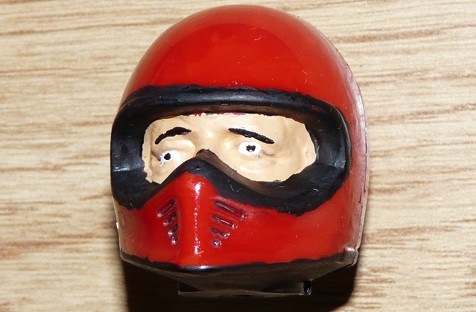
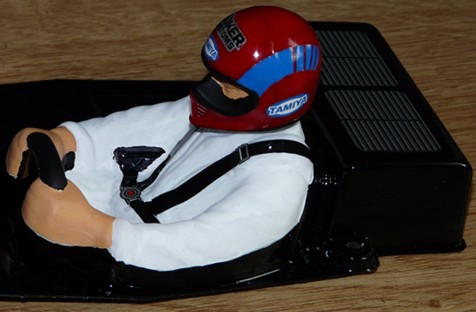
On the left, the finished driver's head before applying the stickers. The zoom gives a good idea about my limited talent in painting though: fortunately, it can hardly been seen from distance. Concerning the stickers, and especially onto the driver's suit, be very cautious to correctly place them right at your first attempt since the paint will not resist if you peel the sticker back. On the other hand, don't worry when applying decals on the helmet: the X-27 lacquer can resist multiple adjustments. I wouldn't say so for any of my other attempts at painting the helmet a different color though.
Now, let's seriously get into the sticker sheets. As mentioned in the manual, follow the sticker numbering since it will be much easier to apply and to cut. Apart from a few stickers on the chassis and rear dampers, most will have to be applied on the bodyshell (more specifically on the front hood).
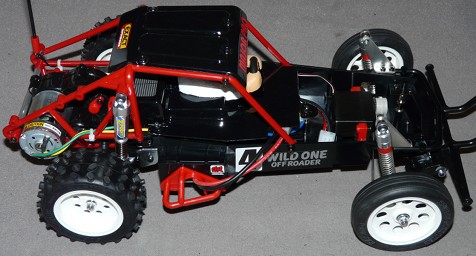
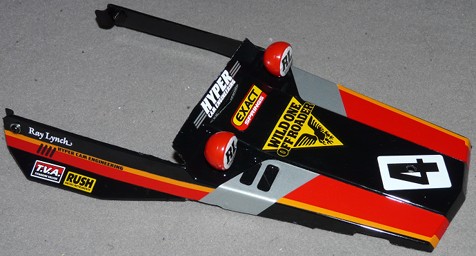
Two things to mention about stickers: first is the Wild One is the re-release of a model from the 80's, which means that decals are not pre-cut. You will need old school scissors and to cut each stickers to their edges to remove transparent film (otherwise, some stickers will not fit). Second is some stickers are very fragile: namely, the two long bands going on the front hood sides. The weakness is located on the metallic gray area: the ink seems to make the sticker more rigid and more fragile when you need to adjust it.




